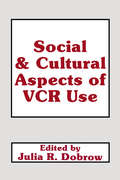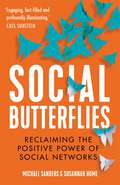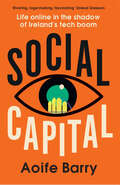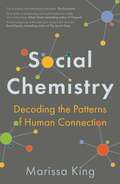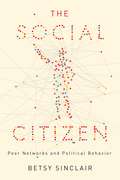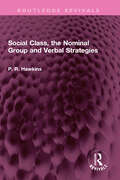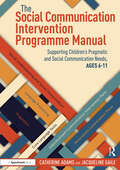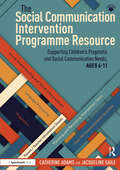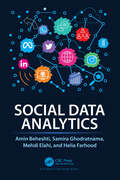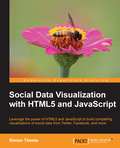- Table View
- List View
Social and Cultural Aspects of Vcr Use (Routledge Communication Series)
by Julie DobrowFirst Published in 1990. Routledge is an imprint of Taylor & Francis, an informa company.
Social Butterflies: Reclaiming the Positive Power of Social Networks
by Michael Sanders Susannah Hume'Engaging, fact-filled and profoundly illuminating. It's inspiring to read – and it should help make the world a lot better.' Cass Sunstein, author of NudgeThe rise of social media has sent our social instincts into overdrive, and the impact of our networks has never been greater. But what if we could reclaim the positive power that influences our decisions, to behave better and be happier? In this groundbreaking book, Sanders and Hume build on the incredible findings of their own cutting-edge research from their work at the world’s first Nudge Unit, as well as illuminating case studies from experts around the world, to show how small changes in our environments can have a huge impact on where our instincts lead us. At a time when our trust in each other is being destroyed on a global scale, it’s never been more important to understand what motivates us and how to use our predictable behaviours to drive positive change. From helping us to run more cohesive organizations, to building important relationships and connections that matter, this is an essential roadmap back to our better social selves.
Social Capital: Life online in the shadow of Ireland’s tech boom
by Aoife BarryA David and Goliath story about Ireland’s role as prime real estate for the world’s largest tech multinationals, and the considerable impact it has had on us as individuals.
The Social CEO: How Social Media Can Make You A Stronger Leader
by Damian CorbetThere remains a huge gulf in understanding by many leaders of what some are calling the Social Age – huge changes going on in society, enabling anyone with a smartphone to sign up to a social network and comment on anything and everything. Despite this revolution, which has been embraced by the masses, it is the people at the top of organizations who have been slowest to understand and adapt to it.While business leaders may feel that it's enough to hire social media managers and amend their marketing strategies, Damian Corbet shows why organizations need to do more to succeed in the Social Age – why CEOs need to 'get social' to survive. The Social CEO sets out to educate and inspire senior leaders to embrace the Social Age, teaching them the hows and whys of utilising social media in order to make them stronger leaders. Social CEOs can effectively encourage engagement from their employees as well as other stakeholders and customers; they're better able to communicate their organization's objectives and values, gauge the climate in which they operate and improve their brand image.Offering invaluable contributions from industry-recognised experts in social business, The Social CEO explores the many aspects of leading in the Social Age, such as storytelling, personal branding, managing risk and public relations. With chapters also written by practising 'social CEOs' working across a variety of sectors, from healthcare to sport, the book provides a wealth of insight into how social media can be used to gain a competitive advantage.
The Social CEO: How Social Media Can Make You A Stronger Leader
by Damian CorbetThere remains a huge gulf in understanding by many leaders of what some are calling the Social Age – huge changes going on in society, enabling anyone with a smartphone to sign up to a social network and comment on anything and everything. Despite this revolution, which has been embraced by the masses, it is the people at the top of organizations who have been slowest to understand and adapt to it.While business leaders may feel that it's enough to hire social media managers and amend their marketing strategies, Damian Corbet shows why organizations need to do more to succeed in the Social Age – why CEOs need to 'get social' to survive. The Social CEO sets out to educate and inspire senior leaders to embrace the Social Age, teaching them the hows and whys of utilising social media in order to make them stronger leaders. Social CEOs can effectively encourage engagement from their employees as well as other stakeholders and customers; they're better able to communicate their organization's objectives and values, gauge the climate in which they operate and improve their brand image.Offering invaluable contributions from industry-recognised experts in social business, The Social CEO explores the many aspects of leading in the Social Age, such as storytelling, personal branding, managing risk and public relations. With chapters also written by practising 'social CEOs' working across a variety of sectors, from healthcare to sport, the book provides a wealth of insight into how social media can be used to gain a competitive advantage.
Social Chemistry: Decoding the Patterns of Human Connection
by Marissa KingSocial Chemistry will utterly transform the way you think about 'networking.' Understanding the contours of your social network can dramatically enhance personal relationships, work life, and even your global impact. Are you an Expansionist, a Broker, or a Convener? The answer matters more than you think. . . . Conventional wisdom would have us believe that it is the size of your network that matters: how many people do you know? We're told to mix, mingle, and connect.But social science research suggests otherwise. The quality and structure of our relationships have far greater impact on our personal and professional lives. our relationships with friends, family, co-workers, neighbours, and collaborators are by far our greatest asset. Yet, most people leave them to chance.In this ground-breaking study, Marissa King, Professor of Organizational Behavior at the Yale, argues that there are strategic ways in which we can alter our relationships for a happier and more fulfilling life. With new understanding, this book can help readers to see how they can harness the power of their networks in their personal relationships, at work, and to create a better world.
The Social Citizen: Peer Networks and Political Behavior (Chicago Studies in American Politics)
by Betsy SinclairHuman beings are social animals. Yet despite vast amounts of research into political decision making, very little attention has been devoted to its social dimensions. In political science, social relationships are generally thought of as mere sources of information, rather than active influences on one’s political decisions. Drawing upon data from settings as diverse as South Los Angeles and Chicago’s wealthy North Shore, Betsy Sinclair shows that social networks do not merely inform citizen’s behavior, they can—and do—have the power to change it. From the decision to donate money to a campaign or vote for a particular candidate to declaring oneself a Democrat or Republican, basic political acts are surprisingly subject to social pressures. When members of a social network express a particular political opinion or belief, Sinclair shows, others notice and conform, particularly if their conformity is likely to be highly visible. We are not just social animals, but social citizens whose political choices are significantly shaped by peer influence. The Social Citizen has important implications for our concept of democratic participation and will force political scientists to revise their notion of voters as socially isolated decision makers.
The Social Citizen: Peer Networks and Political Behavior (Chicago Studies in American Politics)
by Betsy SinclairHuman beings are social animals. Yet despite vast amounts of research into political decision making, very little attention has been devoted to its social dimensions. In political science, social relationships are generally thought of as mere sources of information, rather than active influences on one’s political decisions. Drawing upon data from settings as diverse as South Los Angeles and Chicago’s wealthy North Shore, Betsy Sinclair shows that social networks do not merely inform citizen’s behavior, they can—and do—have the power to change it. From the decision to donate money to a campaign or vote for a particular candidate to declaring oneself a Democrat or Republican, basic political acts are surprisingly subject to social pressures. When members of a social network express a particular political opinion or belief, Sinclair shows, others notice and conform, particularly if their conformity is likely to be highly visible. We are not just social animals, but social citizens whose political choices are significantly shaped by peer influence. The Social Citizen has important implications for our concept of democratic participation and will force political scientists to revise their notion of voters as socially isolated decision makers.
The Social Citizen: Peer Networks and Political Behavior (Chicago Studies in American Politics)
by Betsy SinclairHuman beings are social animals. Yet despite vast amounts of research into political decision making, very little attention has been devoted to its social dimensions. In political science, social relationships are generally thought of as mere sources of information, rather than active influences on one’s political decisions. Drawing upon data from settings as diverse as South Los Angeles and Chicago’s wealthy North Shore, Betsy Sinclair shows that social networks do not merely inform citizen’s behavior, they can—and do—have the power to change it. From the decision to donate money to a campaign or vote for a particular candidate to declaring oneself a Democrat or Republican, basic political acts are surprisingly subject to social pressures. When members of a social network express a particular political opinion or belief, Sinclair shows, others notice and conform, particularly if their conformity is likely to be highly visible. We are not just social animals, but social citizens whose political choices are significantly shaped by peer influence. The Social Citizen has important implications for our concept of democratic participation and will force political scientists to revise their notion of voters as socially isolated decision makers.
The Social Citizen: Peer Networks and Political Behavior (Chicago Studies in American Politics)
by Betsy SinclairHuman beings are social animals. Yet despite vast amounts of research into political decision making, very little attention has been devoted to its social dimensions. In political science, social relationships are generally thought of as mere sources of information, rather than active influences on one’s political decisions. Drawing upon data from settings as diverse as South Los Angeles and Chicago’s wealthy North Shore, Betsy Sinclair shows that social networks do not merely inform citizen’s behavior, they can—and do—have the power to change it. From the decision to donate money to a campaign or vote for a particular candidate to declaring oneself a Democrat or Republican, basic political acts are surprisingly subject to social pressures. When members of a social network express a particular political opinion or belief, Sinclair shows, others notice and conform, particularly if their conformity is likely to be highly visible. We are not just social animals, but social citizens whose political choices are significantly shaped by peer influence. The Social Citizen has important implications for our concept of democratic participation and will force political scientists to revise their notion of voters as socially isolated decision makers.
The Social Citizen: Peer Networks and Political Behavior (Chicago Studies in American Politics)
by Betsy SinclairHuman beings are social animals. Yet despite vast amounts of research into political decision making, very little attention has been devoted to its social dimensions. In political science, social relationships are generally thought of as mere sources of information, rather than active influences on one’s political decisions. Drawing upon data from settings as diverse as South Los Angeles and Chicago’s wealthy North Shore, Betsy Sinclair shows that social networks do not merely inform citizen’s behavior, they can—and do—have the power to change it. From the decision to donate money to a campaign or vote for a particular candidate to declaring oneself a Democrat or Republican, basic political acts are surprisingly subject to social pressures. When members of a social network express a particular political opinion or belief, Sinclair shows, others notice and conform, particularly if their conformity is likely to be highly visible. We are not just social animals, but social citizens whose political choices are significantly shaped by peer influence. The Social Citizen has important implications for our concept of democratic participation and will force political scientists to revise their notion of voters as socially isolated decision makers.
The Social Citizen: Peer Networks and Political Behavior (Chicago Studies in American Politics)
by Betsy SinclairHuman beings are social animals. Yet despite vast amounts of research into political decision making, very little attention has been devoted to its social dimensions. In political science, social relationships are generally thought of as mere sources of information, rather than active influences on one’s political decisions. Drawing upon data from settings as diverse as South Los Angeles and Chicago’s wealthy North Shore, Betsy Sinclair shows that social networks do not merely inform citizen’s behavior, they can—and do—have the power to change it. From the decision to donate money to a campaign or vote for a particular candidate to declaring oneself a Democrat or Republican, basic political acts are surprisingly subject to social pressures. When members of a social network express a particular political opinion or belief, Sinclair shows, others notice and conform, particularly if their conformity is likely to be highly visible. We are not just social animals, but social citizens whose political choices are significantly shaped by peer influence. The Social Citizen has important implications for our concept of democratic participation and will force political scientists to revise their notion of voters as socially isolated decision makers.
Social Class, the Nominal Group and Verbal Strategies (Routledge Revivals)
by P R HawkinsFirst published in 1977, Social Class, the Nominal Group and Verbal Strategies reports on the results of a grammatical analysis of the speech of a large sample (about 300) of five-year-old middle- and working-class children. The author is concerned in particular to answer the questions: What is the relationship, within certain restricted contexts, between the use of particular grammatical structures and factors such as social class, IQ and sex? How are any differences in the type or frequency of structures to be interpreted? The central part of the book presents the results of a set of correlations: the correlations of linguistic categories on the one hand, with sociological or ‘background’ categories on the other. The author then sets this study and its results in the perspective of related research and comments on some aspects of the ‘deficit-difference’ controversy. Finally, he presents his own conclusions in a detailed discussion. He argues that, instead of trying to ascertain the purely linguistic competence of children from different backgrounds, we must rather compare the different verbal strategies they use in a particular situation or context. The book will be of interest to students of language, linguistics, pedagogy and education.
Social Class, the Nominal Group and Verbal Strategies (Routledge Revivals)
by P R HawkinsFirst published in 1977, Social Class, the Nominal Group and Verbal Strategies reports on the results of a grammatical analysis of the speech of a large sample (about 300) of five-year-old middle- and working-class children. The author is concerned in particular to answer the questions: What is the relationship, within certain restricted contexts, between the use of particular grammatical structures and factors such as social class, IQ and sex? How are any differences in the type or frequency of structures to be interpreted? The central part of the book presents the results of a set of correlations: the correlations of linguistic categories on the one hand, with sociological or ‘background’ categories on the other. The author then sets this study and its results in the perspective of related research and comments on some aspects of the ‘deficit-difference’ controversy. Finally, he presents his own conclusions in a detailed discussion. He argues that, instead of trying to ascertain the purely linguistic competence of children from different backgrounds, we must rather compare the different verbal strategies they use in a particular situation or context. The book will be of interest to students of language, linguistics, pedagogy and education.
Social Cognitive Radio Networks (SpringerBriefs in Electrical and Computer Engineering)
by Xu Chen Jianwei HuangThis brief presents research results on social cognitive radio networks, a transformational and innovative networking paradigm that promotes the nexus between social interactions and cognitive radio networks. Along with a review of the research literature, the text examines the key motivation and challenges of social cognitive radio network design. Three socially inspired distributed spectrum sharing mechanisms are introduced: adaptive channel recommendation mechanism, imitation-based social spectrum sharing mechanism, and evolutionarily stable spectrum access mechanism. The brief concludes with a discussion of future research directions which ascertains that exploiting social interactions for distributed spectrum sharing will advance the state-of-the-art of cognitive radio network design, spur a new line of thinking for future wireless networks, and enable novel wireless service and applications.
The Social Communication Intervention Programme Manual: Supporting Children's Pragmatic and Social Communication Needs, Ages 6-11 (The Social Communication Intervention Programme)
by Catherine Adams Jacqueline GaileThe Social Communication Intervention Programme (SCIP) has been developed to support school-aged children (6–11 years) with social communication, pragmatic, and language needs. The Social Communication Intervention Programme Manual provides a rationale and method for providing specialist level language therapy for these children who have significant social communication differences. Evidence for the effectiveness of SCIP is included in The Manual.This book introduces the SCIP model and explores the three main components: social understanding/social inference, pragmatics, and language processing. Guidance is included on how to link assessment with therapy, how to plan and individualise interventions, and how to proceed with the programme. It contains a wealth of real-life case examples to illustrate key points, with step-by-step instructions for carrying out the interventions.Used alongside The Social Communication Intervention Programme Resource, this book offers a truly practical, tried-and-tested model to provide targeted, individualised intervention for children with social communication challenges. It is an essential tool for speech and language therapists, specialist teachers, and psychologists who are working with children with social communication, pragmatic, and language needs.For the most effective use, The SCIP Manual should be purchased alongside The SCIP Resource.
The Social Communication Intervention Programme Manual: Supporting Children's Pragmatic and Social Communication Needs, Ages 6-11 (The Social Communication Intervention Programme)
by Catherine Adams Jacqueline GaileThe Social Communication Intervention Programme (SCIP) has been developed to support school-aged children (6–11 years) with social communication, pragmatic, and language needs. The Social Communication Intervention Programme Manual provides a rationale and method for providing specialist level language therapy for these children who have significant social communication differences. Evidence for the effectiveness of SCIP is included in The Manual.This book introduces the SCIP model and explores the three main components: social understanding/social inference, pragmatics, and language processing. Guidance is included on how to link assessment with therapy, how to plan and individualise interventions, and how to proceed with the programme. It contains a wealth of real-life case examples to illustrate key points, with step-by-step instructions for carrying out the interventions.Used alongside The Social Communication Intervention Programme Resource, this book offers a truly practical, tried-and-tested model to provide targeted, individualised intervention for children with social communication challenges. It is an essential tool for speech and language therapists, specialist teachers, and psychologists who are working with children with social communication, pragmatic, and language needs.For the most effective use, The SCIP Manual should be purchased alongside The SCIP Resource.
The Social Communication Intervention Programme Resource: Supporting Children's Pragmatic and Social Communication Needs, Ages 6-11 (The Social Communication Intervention Programme)
by Catherine Adams Jacqueline GaileThe Social Communication Intervention Programme (SCIP) has been developed to support school-aged children (6–11 years) with social communication, pragmatic, and language needs. SCIP provides a rationale and method for providing specialist level pragmatics and language therapy for these children who have significant social communication differences.The SCIP model is introduced in The Social Communication Intervention Programme Manual, and this book presents the content of the intervention programme itself, using a nested structure of 150 adaptable therapy activities. It contains the complete set of resources required to plan and deliver the interventions set out in the companion book, including forms, activities, and ready-made information sheets. Content can also be downloaded and printed for easy use.Used alongside The Social Communication Intervention Programme Manual, this book offers a truly practical, tried-and-tested model to provide targeted, individualised intervention for children with social communication challenges. It is an essential tool for speech and language therapists, specialist teachers, and psychologists who are working with children with social communication, pragmatic, and language needs.For the most effective use, The SCIP Resource should be purchased alongside The SCIP Manual.
The Social Communication Intervention Programme Resource: Supporting Children's Pragmatic and Social Communication Needs, Ages 6-11 (The Social Communication Intervention Programme)
by Catherine Adams Jacqueline GaileThe Social Communication Intervention Programme (SCIP) has been developed to support school-aged children (6–11 years) with social communication, pragmatic, and language needs. SCIP provides a rationale and method for providing specialist level pragmatics and language therapy for these children who have significant social communication differences.The SCIP model is introduced in The Social Communication Intervention Programme Manual, and this book presents the content of the intervention programme itself, using a nested structure of 150 adaptable therapy activities. It contains the complete set of resources required to plan and deliver the interventions set out in the companion book, including forms, activities, and ready-made information sheets. Content can also be downloaded and printed for easy use.Used alongside The Social Communication Intervention Programme Manual, this book offers a truly practical, tried-and-tested model to provide targeted, individualised intervention for children with social communication challenges. It is an essential tool for speech and language therapists, specialist teachers, and psychologists who are working with children with social communication, pragmatic, and language needs.For the most effective use, The SCIP Resource should be purchased alongside The SCIP Manual.
Social Credit Rating: Reputation und Vertrauen beurteilen
by Oliver EverlingSocial Credit Ratings sind das Ergebnis von Sozialkreditsystemen. Diese umfassen auf verschiedene Datenbanken zugreifende, online betriebene Rating- oder Scoringsysteme, bei denen beispielsweise die Kreditwürdigkeit, das Strafregister und das soziale und gesellschaftliche Verhalten von Personen oder Organisationen wie Unternehmen oder Nichtregierungsorganisationen zur Klassifizierung ihrer Reputation verwendet werden. Das Fahreignungs-Bewertungssystem des Kraftfahrt-Bundesamtes, das für jedermann bestimmte Ordnungswidrigkeiten, Fahrverbote oder Straftaten mit Punkten bewertet und speichert, ist ebenso bekannt und anerkannt wie die SCHUFA-BonitätsAuskunft, der Creditreform-Bonitätsindex oder Noten von Ratingagenturen. Ähnliche Systeme wie Hotelsterne, Verkäuferbewertungen in Online-Shops, Likes, Zertifikate und Zeugniszensuren aller Art sind in Deutschland wie auch in vielen anderen Ländern und weltweit in Social Media verbreitet. Der vom chinesischen Staatsrat beschlossene Aufbau eines staatseigenen Sozialkreditsystems führt solche Ratings und Scorings aufgrund einzigartiger Verknüpfungen in eine neue Dimension, die erst durch die neuen Informations- und Kommunikationstechnologien ermöglicht wurde. Dieses Buch gibt einen tiefen Einblick in die verwendeten Daten, Verfahren, Methoden und Modelle sowie diskutiert Bedeutung, Nutzen, Funktionen, Anwendungsbereiche und auch Risiken und Gefahren von Social Credit Ratings.
Social Data Analytics
by Amin Beheshti Samira Ghodratnama Mehdi Elahi Helia FarhoodThis book is an introduction to social data analytics along with its challenges and opportunities in the age of Big Data and Artificial Intelligence. It focuses primarily on concepts, techniques and methods for organizing, curating, processing, analyzing, and visualizing big social data: from text to image and video analytics. It provides novel techniques in storytelling with social data to facilitate the knowledge and fact discovery. The book covers a large body of knowledge that will help practitioners and researchers in understanding the underlying concepts, problems, methods, tools and techniques involved in modern social data analytics. It also provides real-world applications of social data analytics, including: Sales and Marketing, Influence Maximization, Situational Awareness, customer success and Segmentation, and performance analysis of the industry. It provides a deep knowledge in social data analytics by comprehensively classifying the current state of research, by describing in-depth techniques and methods, and by highlighting future research directions. Lecturers will find a wealth of material to choose from for a variety of courses, ranging from undergraduate courses in data science to graduate courses in data analytics.
Social Data Analytics
by Amin Beheshti Samira Ghodratnama Mehdi Elahi Helia FarhoodThis book is an introduction to social data analytics along with its challenges and opportunities in the age of Big Data and Artificial Intelligence. It focuses primarily on concepts, techniques and methods for organizing, curating, processing, analyzing, and visualizing big social data: from text to image and video analytics. It provides novel techniques in storytelling with social data to facilitate the knowledge and fact discovery. The book covers a large body of knowledge that will help practitioners and researchers in understanding the underlying concepts, problems, methods, tools and techniques involved in modern social data analytics. It also provides real-world applications of social data analytics, including: Sales and Marketing, Influence Maximization, Situational Awareness, customer success and Segmentation, and performance analysis of the industry. It provides a deep knowledge in social data analytics by comprehensively classifying the current state of research, by describing in-depth techniques and methods, and by highlighting future research directions. Lecturers will find a wealth of material to choose from for a variety of courses, ranging from undergraduate courses in data science to graduate courses in data analytics.
Social Data Analytics: Collaboration for the Enterprise (The Morgan Kaufmann Series on Business Intelligence)
by Krish Krishnan Shawn P. RogersSocial Data Analytics is the first practical guide for professionals who want to employ social data for analytics and business intelligence (BI). This book provides a comprehensive overview of the technologies and platforms and shows you how to access and analyze the data. You'll explore the five major types of social data and learn from cases and platform examples to help you make the most of sentiment, behavioral, social graph, location, and rich media data. A four-step approach to the social BI process will help you access, evaluate, collaborate, and share social data with ease. You'll learn everything you need to know to monitor social media and get an overview of the leading vendors in a crowded space of BI applications. By the end of this book, you will be well prepared for your organization’s next social data analytics project.Provides foundational understanding of new and emerging technologies—social data, collaboration, big data, advanced analyticsIncludes case studies and practical examples of success and failuresWill prepare you to lead projects and advance initiatives that will benefit you and your organization
Social Data Visualization with HTML5 and JavaScript
by Simon TimmsThis book is a fast-paced guide full of step-by-step instructions that teach you how to visualize social data using HTML5 and JavaScript.This book is for developers who are excited about data and who want to share that excitement with others. Developers who are interested in the data which can be extracted from social networks will also find this book hugely beneficial.Readers should have a working knowledge of both JavaScript and HTML.
The Social Economics of Health Care
by John B. DavisFor too long now, the issue of health care reform has been dominated by the techniques of mainstream economics and the constant application of the tools of cost-benefit analysis to an area that does not suit it.Issues such as privacy, genetic testing and the allocation of organ transplants require a more sensitive approach to the setting of budgets
